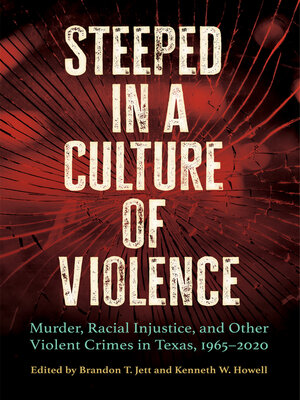Steeped in a Culture of Violence
ebook ∣ Murder, Racial Injustice, and Other Violent Crimes in Texas, 1965–2020 · Elma Dill Russell Spencer Series in the West and Southwest
By Brandon T. Jett

Sign up to save your library
With an OverDrive account, you can save your favorite libraries for at-a-glance information about availability. Find out more about OverDrive accounts.
Find this title in Libby, the library reading app by OverDrive.



Search for a digital library with this title
Title found at these libraries:
| Library Name | Distance |
|---|---|
| Loading... |
The Texas shooting at Santa Fe High School on May 18, 2018, which killed ten and injured thirteen, prompted public debate over the causes and potential solutions to this type of violent episode. On May 21, 2018, National Rifle Association president Oliver North declared that a culture of violence is largely responsible for these killings. "The problem that we've got is we're trying like the dickens to treat the symptom without treating the disease. . . . The disease is youngsters who are steeped in a culture of violence." This debate has captivated the American media and general public for decades.
Texas history is steeped in brutality and bloodshed, creating a narrative that these conditions are still a vital part of the state's culture in the twenty-first century. But perceptions of violence are often at odds with realities on the ground. Over several centuries, violence has decreased with the development of modern society, but popular perception seems to be that a culture of violence has emerged, and perhaps persisted despite demographic, economic, cultural, and political shifts in Texas.
Starting from the notion that a culture of violence existed historically in the state and asking if such a culture still persists in modern Texas, this collection of essays examines trends associated with various types of violence within the state as well as social and political responses from 1965 to 2020. This important and timely work provides valuable context for discussions on violence in the past and for the future.
Texas history is steeped in brutality and bloodshed, creating a narrative that these conditions are still a vital part of the state's culture in the twenty-first century. But perceptions of violence are often at odds with realities on the ground. Over several centuries, violence has decreased with the development of modern society, but popular perception seems to be that a culture of violence has emerged, and perhaps persisted despite demographic, economic, cultural, and political shifts in Texas.
Starting from the notion that a culture of violence existed historically in the state and asking if such a culture still persists in modern Texas, this collection of essays examines trends associated with various types of violence within the state as well as social and political responses from 1965 to 2020. This important and timely work provides valuable context for discussions on violence in the past and for the future.







